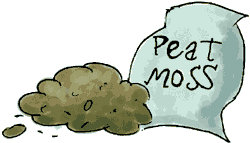Peat Moss
Peat moss is a good, natural conditioner for sandy soil, but trench composting is better. You can also use it to condition clay soil, but leaf compost will help break up the clay and add nutrients.

Peat moss is a spongy moss that is harvested and sold in bags at most garden centers. It is free of weeds and holds lots of moisture, which is why it's an excellent conditioner. However, it won't increase soil fertility, add any nutrients, or encourage worms. Dry peat moss will repel water, so it must be well soaked before you till it into the soil.
- Move the whole bag to where you will use it and cut open the top.
- Fill the bag with water and let it soak overnight.
- When it's wet all the way through, till it into the soil.
- When you water your garden, it will help to hold the moisture in the soil.
Fascinating Facts!
- Peat moss is not actually moss! It is a type of partially decayed plant material that accumulates in wetlands called bogs.
- Peat moss has been used for centuries as fuel in some parts of the world. In fact, during World War II, peat was used as a substitute for coal in some countries.
- Peat moss is an excellent natural soil conditioner because it has a high water-holding capacity and can improve soil structure.
- The acidity of peat moss can range from pH 3.5 to 5.5, which makes it a good growing medium for acid-loving plants such as blueberries and azaleas.
- Peat bogs can be thousands of years old and are often home to unique and rare plant and animal species.
- Peatlands cover only 3% of the Earth's surface, but they store twice as much carbon as all the world's forests combined.
- In some countries, such as Ireland and Scotland, peat has been used for centuries as a source of fuel for home heating and cooking.
soil conditioning
|


